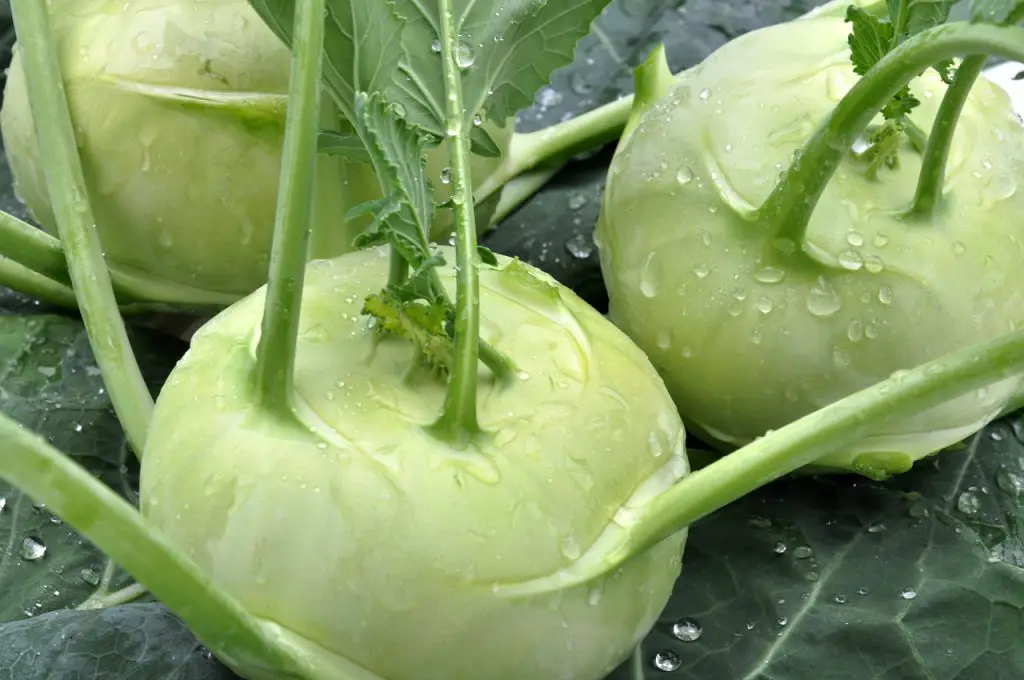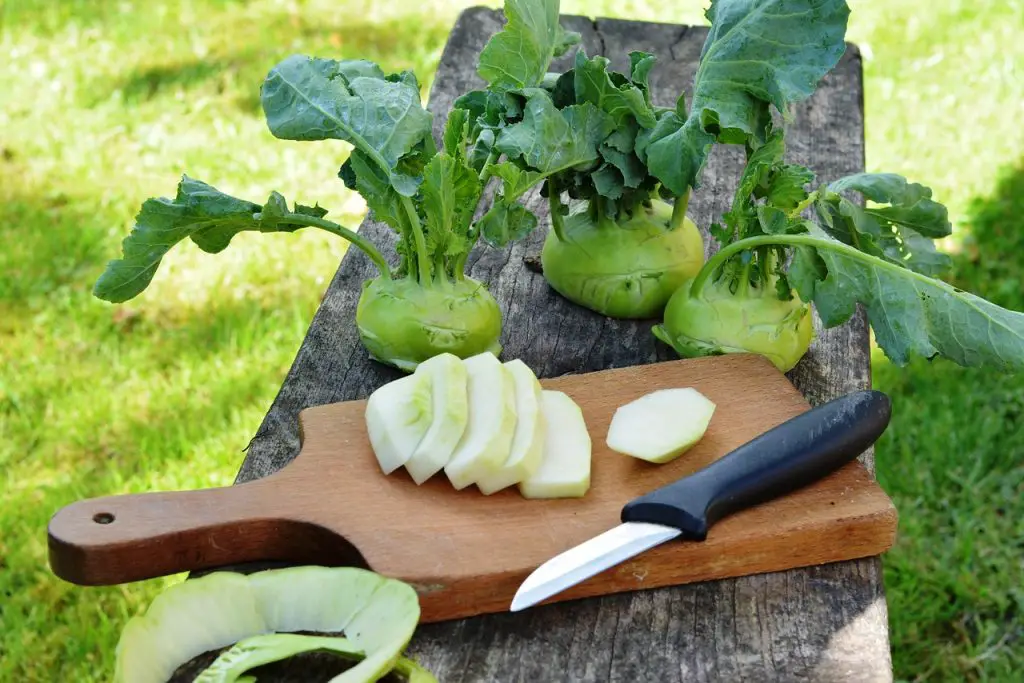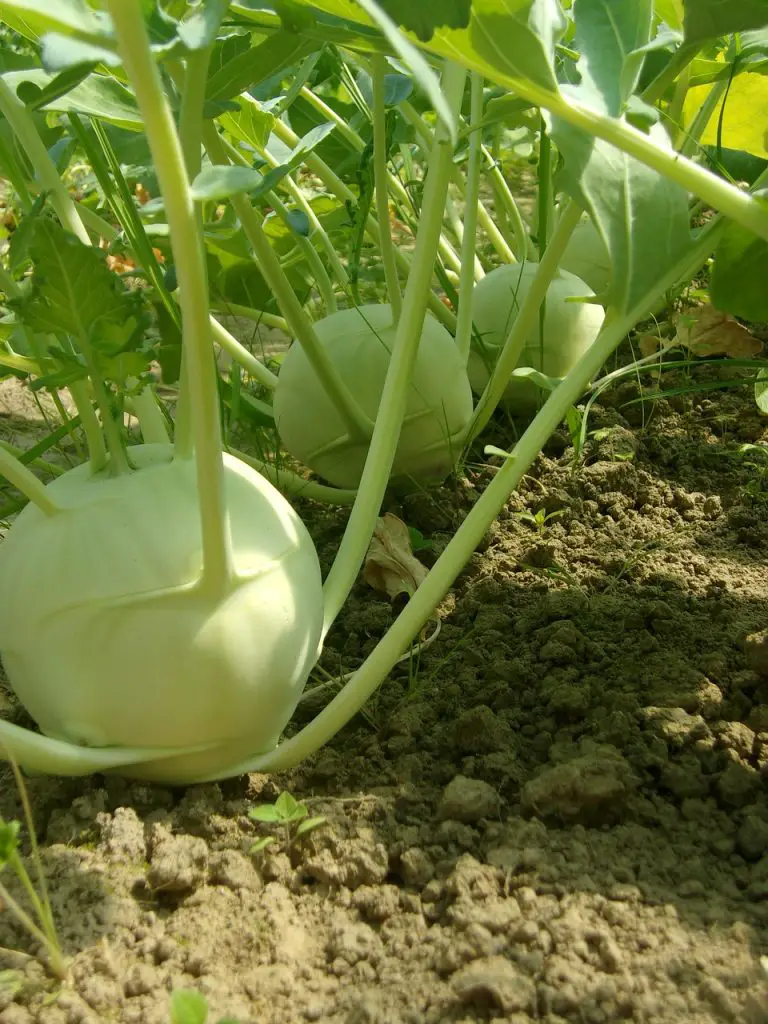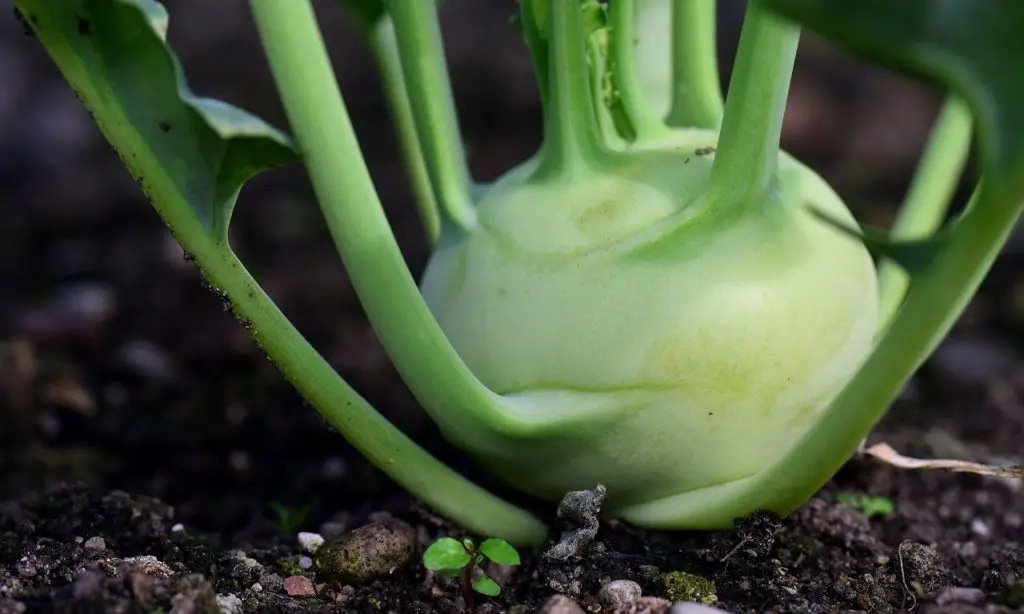The Kohlrabi, also known as the German Turnip, is a member of the Brassica family, along with Cauliflower, Broccoli, Kale and Brussel Sprouts. This unusual looking vegetable originated in Northern Europe, and was very popular during the 16th and 17th Centuries. Historically, it is mainly produced in Germany, Switzerland and did not become known in the United States until the 1800’s. It remains a rarely eaten vegetable in places like Australia, New Zealand, US and the UK.
Kohlrabi has a characteristic swelling within the stem, that kind of looks like a squashed tennis-ball. It is most commonly harvested when this swelling is slightly larger than a golf ball, however, it can grow much larger in Autumn. The swollen stem is the section of the plant that is most commonly eaten, either raw in salads or cooked. The stems and leaves are also edible when cooked, they resemble mild-tasting Swiss Chard or Kale. Kohlrabi is available in green and purple skinned varieties, though the flesh inside the stem is white.
Due to the timing of its growth patterns, its frost tolerance and versatility in the kitchen is well worth trying in your garden. In Spring, it will produce a crop earlier than Potatoes, helping to bridge the hungry gap and maintain a continuous supply of vegetables throughout the year.

What does Kohlrabi Taste Like?
Its flavour is reminiscent of Broccoli, but a little bit milder, and has a texture that is crunchy when raw. Although it is not a root vegetable, it can be treated as one in the kitchen. It can potentially be used as a substitute for other common root vegetables, such as Potatoes, Turnips and Swedes. It has the advantage of being low in carbohydrates, which makes it a great alternative to Potato for those that are trying to either lose weight, or reduce the number of carbohydrates in their diet.
What To Do with Kohlrabi?
Kohlrabi is a very versatile vegetable that can be used in a range of ways. For the uninitiated, the simplest way to try it out, is to roast it like you would a Potato. It can also be used to make chips. If you are feeling a little more adventurous, consider using it raw in salads. Many recipes call for the vegetable to be cut into matchsticks to create a crisp slaw. However, keep it simple as its crunchy, slightly sweet flavour stands up on its own.

How to Grow Kohlrabi
Kohlrabi is a frost tolerant vegetable that is best grown in Spring or Autumn. However, in regions with milder Winters, it can be allowed to stand in the garden for an extended period of time before harvesting. In Spring, smaller golf ball sized Kohlrabi’s can be produced, but the size of the stem is limited by the tendency of the plant to flower in late Spring. When flowering occurs, the stems tend to become woody and increasingly less edible, thus it is recommended to harvest them when they are relatively small in size.
For those wanting a larger Kohlrabi, it is better to sow seeds in late Summer, or very early Autumn as they will not produce flowers at this time of year. As a result, it is possible to allow the Kohlrabi to swell to the size of your hand. These larger stems will also store better than the smaller ones.
One of the lowest cost places to buy Kohlrabi seeds online at Seeds Now. Alternative, if you want to try a few different varieties Seeds for Generations or St Clare Seeds offer some different varieties.
When planting in Spring, sow Kohlrabi seed 4 to 6 weeks before the last average frost date in Spring. Kohlrabi grows best in cool temperatures, between 4 and 20°C (40°F and 70°F), as it reduces the chance of premature flowering. Kohlrabi will mature in 80-100 days from the date of sowing.

Alternatively, Kohlrabi can be sown in late Summer or early Autumn for harvest in Winter. The ideal date for sowing will depend on the severity of the Winters in your region. For those living in harsher climates, it is advisable to sow in Summer. Kohlrabi will tolerate temperatures as low as -9°C (15°F).
In the video below Charles Dowding, a renowned author and market gardener with 30 years experience discusses that best time to sow Kohlrabi to optimise its size.
Plants can be established by direct sowing into soil, however, planting in modular trays is recommended. Once established, seedlings can be planted out at a spacing of 30cms (12 inches). Kohlrabi prefers lower pH soils with plenty of compost, however, they are generally tolerant of most soils. To learn more about how to measure and adjust pH go to https://planyourpatch.com/why-is-ph-important-in-soil/.
During the growth period, they need to be kept moist to avoid stressing the plant. Insufficient water will result in the plant becoming woody, and in Spring it is more likely to flower.

Kohlrabi may be harvested by removing the whole plant when the stem has reached an acceptable size. The roots, stems and leaves should be removed immediately, as this will help with storage.
How to Store Kohlrabi
Contrary to much of the advice on the internet, Kohlrabi will store well for an extended period of time, in Winter. The majority of advice indicates that Kohlrabi will only store for one month in the fridge, however, Kohlrabi’s can be stored for at least 3 months in Winter, if it is kept in a dark, dry and cool area, with the leaves and stem removed. There are no special treatment or conditions required, the Kohlrabi will remain in reasonable condition, if stored in a cardboard box.
